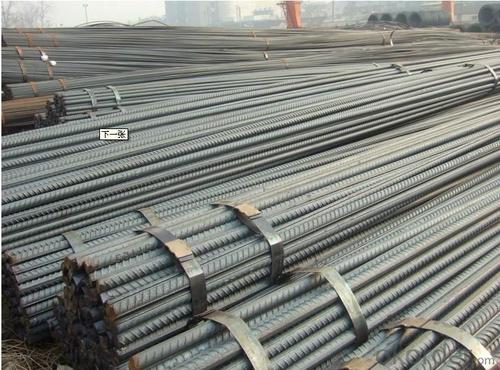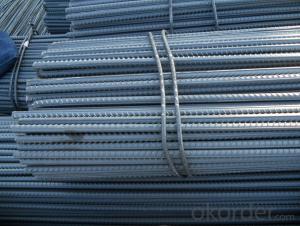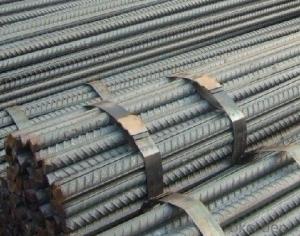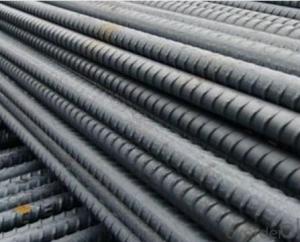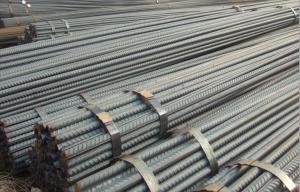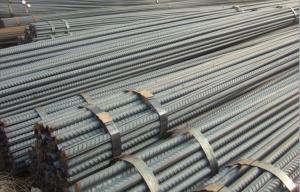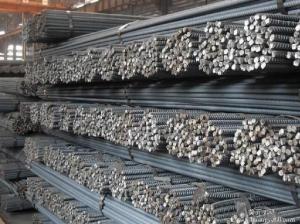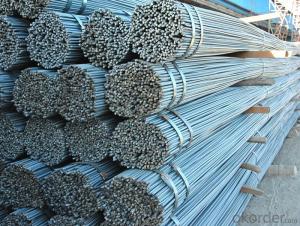High quality deformed bar 6mm-50mm BS4449
- Loading Port:
- Tianjin
- Payment Terms:
- TT OR LC
- Min Order Qty:
- 25 m.t.
- Supply Capability:
- 20000000 m.t./month
OKorder Service Pledge
OKorder Financial Service
You Might Also Like
Product Description:
Product Description:
Specifications of HRB400 Deformed Steel Bar:
Standard | GB | HRB400 | |
Diameter | 6mm,8mm,10mm,12mm,14mm,16mm,18mm,20mm, 22mm,25mm,28mm,32mm,36mm,40mm,50mm | ||
Length | 6M, 9M,12M or as required | ||
Place of origin | Hebei, China mainland | ||
Advantages | exact size, regular package, chemical and mechanical properties are stable. | ||
Type | Hot rolled deformed steel bar | ||
Brand name | DRAGON | ||
Chemical Composition: (Please kindly find our chemistry of our material based on HRB500 as below for your information)
Grade | Technical data of the original chemical composition (%) | ||||||
C | Mn | Si | S | P | V | ||
HRB400 | ≤0.25 | ≤1.60 | ≤0.80 | ≤0.045 | ≤0.045 | 0.04-0.12 | |
Physical capability | |||||||
Yield Strength (N/cm²) | Tensile Strength (N/cm²) | Elongation (%) | |||||
≥400 | ≥570 | ≥14 | |||||
Theoretical weight and section area of each diameter as below for your information:
Diameter(mm) | Section area (mm²) | Mass(kg/m) | Weight of 12m bar(kg) |
6 | 28.27 | 0.222 | 2.664 |
8 | 50.27 | 0.395 | 4.74 |
10 | 78.54 | 0.617 | 7.404 |
12 | 113.1 | 0.888 | 10.656 |
14 | 153.9 | 1.21 | 14.52 |
16 | 201.1 | 1.58 | 18.96 |
18 | 254.5 | 2.00 | 24 |
20 | 314.2 | 2.47 | 29.64 |
22 | 380.1 | 2.98 | 35.76 |
25 | 490.9 | 3.85 | 46.2 |
28 | 615.8 | 4.83 | 57.96 |
32 | 804.2 | 6.31 | 75.72 |
36 | 1018 | 7.99 | 98.88 |
40 | 1257 | 9.87 | 118.44 |
50 | 1964 | 15.42 | 185.04 |
Usage and Applications of HRB400 Deformed Steel Bar:
Deformed bar is widely used in buildings, bridges, roads and other engineering construction. Big to highways, railways, bridges, culverts, tunnels, public facilities such as flood control, dam, small to housing construction, beam, column, wall and the foundation of the plate, deformed bar is an integral structure material. With the development of world economy and the vigorous development of infrastructure construction, real estate, the demand for deformed bar will be larger and larger..
Packaging & Delivery of HRB400 Deformed Steel Bar:
Packaging Detail: products are packed in bundle and then shipped by container or bulk vessel, deformed bar is usually naked strapping delivery, when storing, please pay attention to moisture proof. The performance of rust will produce adverse effect.
Each bundle weight: 2-3MT, or as required
Payment term: TT or L/C
Delivery Detail: within 45 days after received advanced payment or LC.
Label: to be specified by customer, generally, each bundle has 1-2 labels
Trade terms: FOB, CFR, CIF
- Q: What is the tensile strength of a steel rebar?
- The tensile strength of a steel rebar typically ranges from 60,000 to 100,000 pounds per square inch (psi).
- Q: How do steel rebars affect the overall structural stability of a building?
- Steel rebars play a critical role in enhancing the overall structural stability of a building. These reinforcing bars are commonly used in concrete structures to provide additional strength and support to the building's framework. By embedding steel rebars within the concrete, the overall structural integrity and load-bearing capacity of the building are significantly increased. The primary function of steel rebars is to reinforce and strengthen the concrete, which is vulnerable to tension forces. Concrete has excellent compressive strength but has limited resistance to tensile forces. Steel rebars, being highly tensile in nature, are able to counteract these tension forces and prevent the concrete from cracking or failing under stress. Rebars are strategically placed within the concrete to distribute and transfer loads more efficiently. This redistribution of forces helps to reduce the chances of localized structural failures and ensures that the building can withstand various external forces, such as wind, seismic activity, or heavy loads. Moreover, steel rebars also enhance the durability and longevity of a building. By reinforcing the concrete, rebars help to minimize cracking and prevent the propagation of cracks. This is particularly crucial in areas prone to seismic activity, as the rebars can absorb and dissipate the energy generated during an earthquake, reducing the risk of collapse. In addition to their role in ensuring structural stability, steel rebars also offer flexibility in design. They can be shaped and bent into various configurations, allowing architects and engineers to create complex and innovative structures with ease. This flexibility in design not only improves the aesthetics of the building but also enables the construction of unique architectural features that would otherwise be challenging or impossible to achieve. In summary, steel rebars are essential for enhancing the overall structural stability of a building. By reinforcing the concrete, they increase its load-bearing capacity, improve resistance to tensile forces, and distribute loads more efficiently. Their presence significantly reduces the risk of structural failure, enhances durability, and allows for greater design flexibility.
- Q: Can steel rebars be used in structures with high resistance to vibration?
- Yes, steel rebars can be used in structures with high resistance to vibration. Steel rebars are commonly used as reinforcement in concrete structures to increase their strength and durability. The use of steel rebars enhances the structural integrity of a building or infrastructure, making it more resistant to various forces, including vibrations. Steel rebars possess excellent tensile strength and stiffness, which allows them to absorb and distribute the applied loads evenly throughout the structure. This property helps to minimize localized stress concentrations that could lead to vibrations or structural failure. Additionally, steel rebars can effectively control the crack widths and prevent the propagation of cracks, further enhancing the structure's resistance to vibrations. Moreover, steel rebars can be designed to meet specific requirements based on the expected vibration levels. By utilizing rebars with appropriate diameters, spacing, and anchorage details, the structure can be engineered to withstand vibrations caused by various external factors, such as earthquakes, wind loads, or nearby machinery. It is crucial to ensure proper design and detailing of steel rebars in structures with high resistance to vibration. The reinforcement layout should be carefully planned to account for the anticipated forces and vibrations. Additionally, the rebars should be adequately anchored and connected to other structural members to maintain their effectiveness in resisting vibrations. Overall, steel rebars are a reliable and widely-used reinforcement material that can significantly enhance the resistance of structures to vibrations when designed and implemented correctly.
- Q: What are the different coating options available for steel rebars?
- There are several coating options available for steel rebars, including epoxy coating, galvanized coating, and polyethylene wrapping. Epoxy coating provides corrosion resistance and can be applied as a liquid or powder coating. Galvanized coating involves dipping the rebar in molten zinc to form a protective layer against rust and corrosion. Polyethylene wrapping is a plastic film that is wrapped around the rebar to provide a barrier against moisture and chemical exposure. These coating options help extend the lifespan and durability of steel rebars in various applications.
- Q: Are there any limitations on the length of steel rebars?
- Industry standards and guidelines typically dictate the length of steel rebars, imposing limitations based on practical and logistical factors. One restriction pertains to the transportation and handling of rebars. Although steel rebars are usually produced in lengthy sizes, such as up to 60 feet (18 meters) or more, the weight and rigidity of rebars make it challenging to transport and maneuver them effectively. Therefore, rebars are commonly cut into shorter lengths for easier transportation and handling on construction sites. Another limitation concerns the structural integrity of rebars. Lengthier rebars are more susceptible to bending, warping, or sagging, which can compromise their effectiveness in reinforcing concrete structures. To ensure structural integrity, rebars are often restricted to specific lengths based on the particular application and design requirements. Furthermore, local building codes and regulations may impose additional limitations. These regulations aim to guarantee the safety and durability of structures. They might stipulate the maximum length of steel rebars permissible for different construction applications to meet the required standards and ensure the building's structural integrity. In conclusion, while steel rebars can be manufactured in extended lengths, considerations such as practicality, structural integrity, and compliance with local regulations often impose limitations on their size. These limitations are in place to facilitate the efficient transportation and handling of rebars, maintain their structural integrity, and adhere to building codes and regulations.
- Q: How do steel rebars provide reinforcement to concrete?
- Steel rebars provide reinforcement to concrete by adding strength and durability to the structure. When embedded within the concrete, rebars act as tension members, resisting forces that would otherwise cause cracking or failure. The high tensile strength of steel rebars helps to distribute and absorb load, enhancing the overall structural integrity of the concrete.
- Q: How are steel rebars measured and priced in the market?
- Steel rebars are typically measured and priced in the market based on their diameter and length. The diameter of the rebars is measured in millimeters, and the length is usually in meters. The pricing is determined by factors such as the current market demand, the cost of raw materials, and any additional processing or customization. Additionally, the pricing may also vary depending on the grade or quality of the steel rebars, with higher-grade rebars generally commanding a higher price.
- Q: Are there any environmental concerns associated with steel rebar production?
- Yes, there are environmental concerns associated with steel rebar production. The process of extracting iron ore and other raw materials, as well as the high energy consumption in steel production, contribute to greenhouse gas emissions and air pollution. Additionally, the disposal of waste materials and the potential for water pollution during manufacturing can also pose environmental risks. However, advancements in technology and the adoption of more sustainable practices in steel production can help mitigate these concerns.
- Q: Can steel rebars be used in structures with limited foundation support?
- Yes, steel rebars can be used in structures with limited foundation support. Steel rebars are commonly used as reinforcement in concrete structures to enhance their strength and durability. In structures with limited foundation support, the steel rebars can help distribute the load more evenly throughout the structure, minimizing the stress on the foundation. Additionally, the use of steel rebars can also increase the overall stability of the structure. However, it is important to note that the design and placement of the rebars should be done by a qualified engineer to ensure that they are properly integrated into the structure and can effectively bear the load.
- Q: What is the difference between grade two and three grade steel?
- But from the definition we can see more of the same point, all belong to the common low alloy hot rolled ribbed steel bars; belong to (usually said that the rebar); can be used for engineering in reinforced concrete structure.
Send your message to us
High quality deformed bar 6mm-50mm BS4449
- Loading Port:
- Tianjin
- Payment Terms:
- TT OR LC
- Min Order Qty:
- 25 m.t.
- Supply Capability:
- 20000000 m.t./month
OKorder Service Pledge
OKorder Financial Service
Similar products
Hot products
Hot Searches
Related keywords



